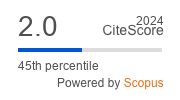Design innovation integrating deep technology, societal needs, radical innovation, and future thinking: a case study of the CBI A3 program
DOI:
https://doi.org/10.23726/cij.2021.1291Keywords:
design methods, social innovation, deep technology, self-efficacy, tertiary educationAbstract
There is a recognized need for innovators with design capability to translate deep technology into applications that consider desirable futures and positive societal impact. Challenge Based Innovation A3 (CBI A3) is an interdisciplinary program that aims to develop such capability in university students’ using an integrated curriculum featuring design skills combining four domains: deep technology, societal needs, radical innovation and future thinking. This paper describes the CBI A3 program and discusses exploratory research using a mixed methods approach of observations, reflections, and before and after surveys measuring growth in student confidence. Initial findings indicate CBI A3 program achieves its learning objectives, recommending further in-depth research to validate findings and broaden understanding of specific tools and curriculum approaches for both professional practice and educational settings.
References
Alphabeta (Australia part of Accenture), 2020, Australia’s Deep Tech Opportunity: Insights from the Cicada Innovations Journey, A report undertaken on behalf of Cicada Innovations.
Anderson, D.M., 2013, Overarching Goals, Values, and Assumptions of Integrated Curriculum Design, SCHOLE: A Journal of Leisure Studies and Recreation Education, 28(1): pp.1-10. DOI: 10.1080/1937156X.2013.11949690.
ATTRACT, 2021, ATTRACT phase 2 Developing breakthrough technologies for science and society, Retrieved 8th May 2021: https://attract-eu.com
Bandura, A., 1977, Self-efficacy: toward a unifying theory of behavioral change. Psychological review, 84(2), p.191.
Bandura, A., 2006, Guide for constructing Self-efficacy scales. In Self-Efficacy Beliefs of Adolescents, Pajares, F. & Urdan, T.S. (eds.) Information Age Publishing: Greenwich, pp. 307-337.
Carberry, A. R., Gerber, E. M., & Martin, C. K. (2018). Measuring the innovation self-efficacy of engineers∗. International Journal of Engineering Education, 34(2), 590-598.
Chow, J., 2019, What is Deep Tech? Deep Tech Defined, DeepTechWired, Retrieved 9th May, 2021: http://deeptechwire.com/what-is-deep-tech/
Doorley, S., Holcomb, S., Klebhan, P., Segovia, K. & Utley, J., 2018, Design Thinking Bootleg, Guide produced by D.School at Stanford University.
Drake, S.M. & Reid, J.L., 2018, Integrated Curriculum as an Effective Way to Teach 21st Century Capabilities, Asia Pacific Journal of educational Research, 1(1): pp. 31-50.
Fogarty, R., 1991, The mindful school: How to integrate the curriculum, Skylight publishing, Inc.: Palatine, IL.
Gerber, E., Martin, C.K., Kramer, E., Braunstein, J., & Carberry, A.R., 2012, Work in Progress: Developing an Innovation Self-efficacy survey, 2012 Frontiers in Education Conference Proceedings, 2012, Seattle, pp. 1-3.
Harvard Computer Society, 2020, Tech for Social Good, Retrieved 8th May 2021: https://socialgood.hcs.harvard.edu
Mesa, D., Thong, C., Ranscombe, C. & Kuys, B., 2019, Integrating the product development process in scientific research. Bridging the research-market gap, Proceedings of the Design Society: 22nd International Conference on Engineering Design (ICED19), Delft.
Norman, D.A. & Verganti, R., 2014, Incremental and Radical Innovation: Design Research vs. Technology and Meaning, Design Issues, 30(1): pp. 78-96.
Lande, M. & Leifer, L., 2010, Difficulties student engineers face designing the future, International Journal of Engineering Education, 26(2): pp. 271-277.
Pink, S., Rieken, B., Bjorklund, T., & Sheppard, S., 2017, What Makes an Inquisitive Engineer? An Exploration of Question-Asking, Self-Efficacy, and Outcome Expectations among Engineering Students, Proceedings of the American Society for Engineering Education Annual Conference and Exposition, 2017 Columbus, OH.
Sambasivan, N., 2019, The remarkable illusions of technology for social good, Interations, 26(3): pp. 64-66.
SGInnovate, 2020, SGInnovate Launches Deep Tech for Good Initiative, Retrieved 8th May 2021: https://www.sginnovate.com/news/sginnovate-launches-deep-tech-good-initiative
Stanford University, 2021, Ethics, Society, and Technology Hub. Retrieved May 8th 2021: https://ethicsinsociety.stanford.edu/ethics-society-technology-hub
UK Design Council., 2018, Designing a Future Economy. Retrieved 13th June 2021: https://www.designcouncil.org.uk/sites/default/files/asset/document/Designing_a_future_economy18.pdf
UK Design Council., 2019, What is the Framework for Innovation? Design Council’s Evolved Double Diamond. Retrieved 23rd March 2021: https://www.designcouncil.org.uk/news-opinion/what-framework-innovation-design-councils-evolved-double-diamond
UK Design Council., 2021, Beyond Net Zero: A Systemic Design Approach. Retrieved 8th May 2021: https://www.designcouncil.org.uk/resources/guide/beyond-net-zero-systemic-design-approach
Verganti, R., 2009, Design-Driven Innovation: changing the rules of competition by radically innovating what things mean, Harvard Business Press, Boston, USA.
World Economic Forum, 2020, The Future of Jobs Report October 2020, Retrieved 9th May 2021: http://www3.weforum.org/docs/WEF_Future_of_Jobs_2020.pdf
Downloads
Published
How to Cite
Issue
Section
Categories
License
Copyright (c) 2021 Christine Thong, Andreea Cotaranu, Aaron Down, Kirstin Kohler, Catarina Batista

This work is licensed under a Creative Commons Attribution 4.0 International License.
Authors who publish with this journal agree to the following terms:
- Authors retain copyright and grant the journal right of first publication with the work simultaneously licensed under a Creative Commons Attribution License that allows others to share the work with an acknowledgement of the work's authorship and initial publication in this journal.
- Authors are able to enter into separate, additional contractual arrangements for the non-exclusive distribution of the journal's published version of the work (e.g., post it to an institutional repository or publish it in a book), with an acknowledgement of its initial publication in this journal.
- Authors are permitted and encouraged to post their work online (e.g., in institutional repositories or on their website) prior to and during the submission process, as it can lead to productive exchanges, as well as earlier and greater citation of published work (See The Effect of Open Access).


